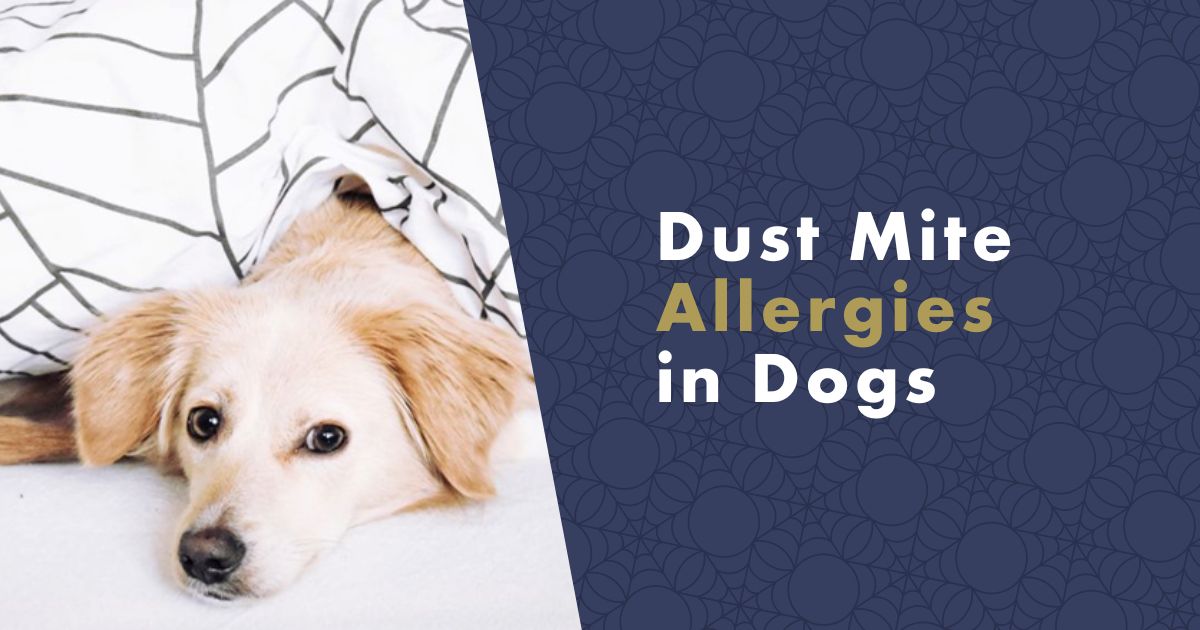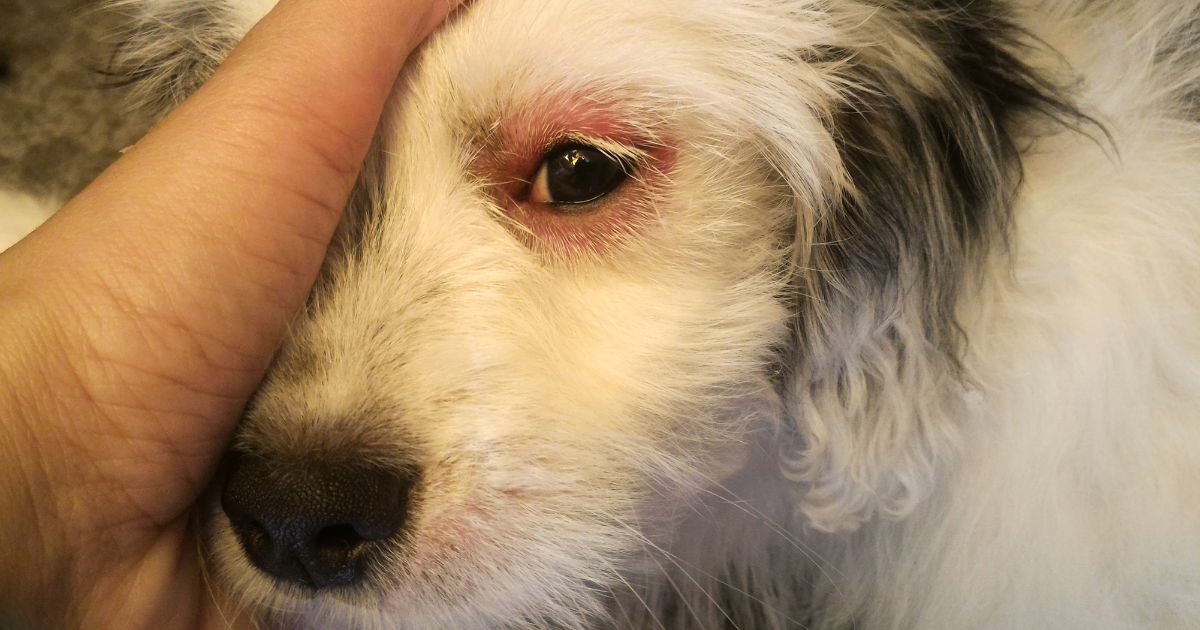Not only do people suffer from various allergies, but our four-legged friends can also be allergic. Dogs can be allergic to a variety of allergens from dust mites, to pollens, to food allergies. However, in our article, we will focus on dust mite allergies in dogs, their symptoms, treatment, and prevention.

Allergies in Dogs
Allergies in our furry friends, dogs, are a common health issue that can cause unpleasant troubles. Allergens that dogs may react to are often similar to those in humans — pollens, molds, insects, dust mites, foods, and more.
Among the most common symptoms of allergies in dogs are:
- itchiness, scratching,
- restlessness,
- irritability,
- insomnia,
- red skin,
- intestinal issues,
- red, swollen eyes,
- dandruff, crusts on the skin,
- bald patches.
If you notice any of these symptoms in your dog, do not hesitate to visit a veterinarian. There are medications for dog allergies that can relieve them from allergy symptoms.
Dust Mite Allergies in Dogs: How It Manifests
A very common allergy in dogs is precisely allergy to dust mites — affecting up to a third of dogs. Dust mites are microscopic organisms that belong to the order of arachnids and can be found in various environments, including homes and beds.
In dogs, the most common type of mites are house dust mites and storage mites.

Tip: Check out our blog post, Dust Mites: Everything You Need to Know.
Each dog reacts differently to dust mites and may have varying degrees of allergic reaction, but it usually involves a skin reaction — the dog's skin becomes red, itchy, and the dog scratches and bites.
The source of dust mites that trigger allergies in dogs can be dog beds, sofas, pillows, beddings, or carpets. However, there are also food mites that nest in dog food.
Symptoms of Dust Mite Allergies in Dogs
As mentioned earlier, it usually involves a skin allergic reaction. Among the most common symptoms of dust mite allergies in dogs are:
- itchiness,
- redness of the skin,
- hair loss,
- skin inflammation,
- frequent scratching,
- bald patches, dandruff, and crusts on the skin.
Diagnosis of Dust Mite Allergies in Dogs
If you suspect that your dog may have a dust mite allergy, it is essential to visit a veterinarian. The veterinarian will conduct a thorough examination and may perform skin tests to confirm the diagnosis.
Dog Allergy Test
When determining a specific allergy, a veterinarian may perform a so-called allergen test. This involves taking the necessary amount of the dog's serum, which is then examined in the laboratory.
The test result will determine the type of allergy, and the veterinarian will set up an individual treatment plan for your pet's specific needs.

Tip: If your dog sleeps in bed with you, it's a good idea to equip it with anti-dust mite bedding.
Treatment and First Aid for Dust Mite Allergies in Dogs
The first step in treating dust mites is thorough cleaning and disinfection of all areas where the dog lies, such as dog beds, blankets, pillows, and even brushes for fur. Then, it is necessary to visit a veterinarian, who will examine your dog and establish the necessary treatment plan.
The veterinarian may prescribe medications or shampoo for the dog, which relieve symptoms of dust mite allergy. Another possible treatment is special diet in the form of hypoallergenic food or immunotherapy.
However, it is essential to realize that proper and timely treatment of dust mite allergy in dogs may alleviate symptoms, but the allergy itself is not entirely curable.
Prevention of Dust Mite Allergies in Dogs
Prevention is always better than treating dust mite allergy. Try to follow these measures to prevent health problems in your pet:
- Keep your home clean: Regularly vacuum and mop floors, sofas, beds, and other places where your dog spends time.
- Keep your dog clean: Bathe your dog as needed with anti-parasitic shampoo.
- Regularly wash bedding and toys: Your dog's bed and toys can be a breeding ground for dust mites. Regularly wash and disinfect them or get your dog anti-dust mite dog bed.
- Set up a special diet for your dog: You can feed your dog hypoallergenic food, or you can give him dietary supplements and oils.
#produkty#https://www.nanospace.store/dog-beds/
Tip: Read about allergy to dogs: Symptoms and how to recognize them.
Frequently Asked Questions:
How often should I check my dog's bedding?
Ideally, you should check your dog's bed at least once a week to prevent dust mite buildup.
Is dust mite allergy in dogs hereditary?
Allergy to dust mites may not be hereditary, but certain breeds are more prone to it.
Can dust mite allergies cause serious complications?
If left untreated, dust mite allergy can cause serious skin problems and infection.
How long does treatment for dust mite allergy last?
The duration of treatment depends on the severity of the allergy and the chosen treatment method. It can take several weeks to months.
Can I use home remedies to treat dust mite allergy in dogs?
Home remedies can help alleviate symptoms, but it's important to consult with a veterinarian about everything.
How do you recognize dust mites?
Dust mites are members of the order of arachnids, and most of them are not visible to the naked eye. You can recognize dust mites by the reaction of the dog's skin. The dog may scratch, bite, or lose hair. Its skin reddens and may have a rash or pimples.
Sources
- LEE, Sang Pyo, et al. A pilot study of intralymphatic immunotherapy for house dust mite, cat, and dog allergies. Allergy, asthma & immunology research, 2017, 9.3: 272-277.
- FERNÁNDEZ-CALDAS, Enrique. On mite allergy in dogs and humans. International Archives of Allergy and Immunology, 2013, 160.4: 329.
- BENSIGNOR, Emmanuel; CARLOTTI, Didier N. Sensitivity patterns to house dust mites and forage mites in atopic dogs: 150 cases. Veterinary Dermatology, 2002, 13.1: 39-44.
- PEPYS, J.; CHAN, Moira; HARGREAVE, F. E. Mites and house-dust allergy. The Lancet, 1968, 291.7555: 1270-1272.
- DE WECK, Alain L., et al. Dog allergy, a model for allergy genetics. International archives of allergy and immunology, 1997, 113.1-3: 55-57.

